To There and Back Again Achieve Bns
Bambi is a 1942 American animated film produced by Walt Disney and based on the book Bambi: A Life in the Woods by Austrian author Felix Salten. The fifth film in the Disney Animated Canon, it was released by RKO Radio Pictures on August 21, 1942, during World War II. It is the last Disney animated film to be in a single-narrative format until nearly eight years later with Cinderella due to the decrease of resources in World War II causing the studio to make "package features" to stay the studio afloat for financial reasons.
The main characters are Bambi, his parents (the Great Prince of the Forest and his unnamed mother), his friends, Thumper and Flower, his childhood friend, Faline, and the villain of the story, Man. The plot centers around Bambi learning to grow up in the forest after his mother is shot by Man. For the film, Disney took the liberty of changing Bambi's species into a white-tailed deer from his original species of roe deer, since roe deer do not inhabit the United States, and the white-tailed deer is more familiar to Americans. The film received three Academy Award nominations for Best Sound, Best Song for "Love is a Song" and Original Music Score.
The film was a major catalyst in what people now see as "environmental films", as well as Walt Disney's favorite of his animated films. In June 2008, the American Film Institute presented a list of its "10 Top 10", the best ten films in each of ten "classic" American film genres. After polling over 1,500 people from the creative community, the film placed third in animation. In December 2011, the film was added to the National Film Registry of the Library of Congress for being "culturally, historically and aesthetically significant".
A direct-to-video midquel, titled Bambi II, was released in 2006.
Synopsis
The film begins with a long camera shot through the forest at dawn, and all the animals waking up. Suddenly, a blue bird spreads the news about something. Thumper (a young rabbit) wakes up an old owl named "Friend Owl", who asks what has happened. Thumper and his sisters tell him that the new prince is born. Friend Owl flies off to the area where the young prince is born, along with many other animals. Upon reaching the area, the animals come across the mother doe and her newborn fawn lying by her side. The animals congratulate her. She then urges her new fawn to wake up and see everybody. He wakes up and takes a good, long look at all the animals surrounding him. At first, he is frightened by Friend Owl, who gives a friendly hoot but then manages to make a smile. He then attempts to get up, but due to him being very young, he can hardly keep his balance. Thumper comments that he is sort of unstable, to which his mother scolds him. The young prince then falls backward back into his resting spot, causing some laughter and delight among the creatures. The fawn then lies back into his resting area and gives a big yawn. Friend Owl says to the creatures that it may be time for them to leave. They all leave, except for Thumper, who asks the fawn's mother what his name will be. She replies that she will name him "Bambi." Thumper, liking the name, says goodbye to her and runs off to join his family. Happy with the name, Bambi's mother snuggles up with her sleeping fawn. The camera then pulls up from the small bush to reveal Bambi's father, the Great Prince of the Forest, looking down at them from a nearby cliff ledge.
A few days later, Bambi and his mother are taking a walk through the forest. Bambi falls behind a little, getting distracted by some greeting animal neighbors. When trying to catch up to his mother, he gets stuck on a tall, thick blade of grass and slips. Upon seeing him fall, Thumper and his family run over to the young prince, asking his mother if he is alright. She replies that he is doing fine. Thumper is then reminded of a lesson his father told him earlier in the morning. Bambi then gets back up onto his feet and can continue walking, with Thumper and his sisters journeying alongside him. They soon come across several birds eating some berries. Thumper then teaches Bambi how to say "bird", who does not get it right the first time, but with some encouragement from his sisters, he is able to say it, shouting out on the top of his lungs, "Bird!" Happy with his success, Thumper and his sisters run off to tell Bambi's mother and their mother what the young prince's first word was, while Bambi runs off chasing a butterfly (thinking it to be a bird). Thumper tells him that it is not a bird but a butterfly. The butterfly flies off, leaving Bambi to think that the huge yellow flower in front of him was the butterfly he saw. Thumper tells him that it is a flower. Bambi tries smelling the flowers of the small field but comes face to face with a young skunk. Bambi calls him a flower, which leaves Thumper rolling over his backside with laughter. The skunk, however, says that he's fine with being called a flower, which makes the baby fawn very happy.
The day grows late, and it is time for Thumper to return home, leaving Bambi back with his mother. Off in the distance, a thunderstorm is gathering and coming closer. He is then awakened by the noise of some nearby raindrops, which then form a small brook flowing right past his resting area. Soon, the whole forest is alive with raindrops dropping about. The creatures living in the forest run for shelter from the falling water. Suddenly, the violent part of the storm comes when lightning bolts flash about in a bright flash of light and produces many loud noises, leaving Bambi frightened. Soon, the storm departs, and the sunrise off in the distance is slowly seen. Bambi, now asleep next to his mother's side, snuggles up with his mother as the last drops of the storm fall into the nearby overflowing brook.
The next scene opens up a few weeks later when Bambi is now capable of speaking. His mother is going to take him to the meadow. Bambi, who has never been to the meadow before, is eager to go, but his mother stops and tells him that the meadow is also a dangerous place. She tells him to stay behind the thicket while she looks around to see if the place is safe. After a long moment of silence, which is broken by a flock of birds flying in toward the grass, the wide-field appears to be safe. Bambi then runs out and tries to catch up with his mother, who runs off fast, playing with him. After a while, Bambi walks off and finds Thumper and his family grazing on greens and flowers, to which he briefly joins in; Thumper suggests that Bambi eat the blossoms, but before he can eat one of the blossoms, his mother reminds him of his father's advice about eating the blossoms and leaving the greens, to which the kitten reluctantly recites that eating greens is a special treat, as it makes long ears and big feet, making up the fact that it is awful stuff to eat. Before Bambi can eat more greens, a frog leaps from the vegetation croaking 'Watch out!". He follows the frog over to a small pool of water, which the frog jumps in. Bambi, however, is left out on the shore, staring at his never before seen reflection. He tries to sample the scent, but fails. Suddenly, another reflection appears to his side. He looks up at the unknown source, which turns out to be another fawn, a female fawn. Feeling frightened of the young fawn's presence, Bambi runs back up to his mother for protection. The second fawn follows suit. The young fawn's name turns out to be Faline. Bambi's mother encourages Bambi to say hello to her. Having no choice, he greets her. Faline suddenly breaks out in giggles and starts acting hyperactive, backing him into a nearby pond through a wall of grass. Gradually, the two of them start playing a small game of tag.
Suddenly, from out of the surrounding forest, a huge herd of bucks appears from nowhere. Faline runs away in fear while Bambi remains, filled with excitement while watching the bucks bound across the field. He even tries running alongside them but ends up almost getting trampled, taking cover inside a log. Suddenly, they all stop. Wondering why, Bambi walks over. The reason appears in front of him. It is no other than the Great Prince. After a brief look at him, the Great Prince walks off, leaving him behind. He then asks his mother why everyone stood still when the mysterious stag walked by. She tells him that he is respected by all. Thus explaining why he is called "The Great Prince of the Forest".
The next part follows the Great Prince during his walk through the forest. Suddenly, the forest's silence is broken when a flock of crows flies past, yelling and spreading out an alarm of certain danger. The Great Prince senses this danger and runs back towards the meadow. Once there, he warns the herd. Sensing the danger as well, the herd and all the other creatures begin to run towards the forest. Soon, the whole meadow is full of retreating frightened animals, running for their lives. Faline and Thumper unite with their mothers and escape, but Bambi gets left behind, searching for his mother. His mother is looking for him as well. Suddenly, the meadow is completely empty. Though everything is still, something dangerous and deadly is still approaching. Sensing the danger but still frightened, Bambi is left out in the open, still searching for his mother. Suddenly, the Great Prince appears from behind him and escorts him and his mother to the safety of the forest. Off in the distance, a loud gunshot is heard. A few minutes later, Bambi's mother exits the entrance of their den and looks around. Seeing no danger, she tells Bambi that everything is alright. Bambi asks her what had happened and why everyone ran. After a moment of silence, his mother replies, "Man... was in the forest."
Autumn arrives, and leaves are seen falling, and as the deer walk alongside a stream, Bambi stops in his tracks and watches the leaves fall onto the water. More leaves fall, down to the final two leaves.
During the winter, Bambi discovers snow. While Bambi looks around the snow, he sees Thumper sliding on the ice. He teaches Bambi how to slide on the ice, but it is rather very tough for the fawn, as he keeps losing his footing on the ice. After that, they meet Flower, who is trying to hibernate. After a harsh winter spent browsing on tree bark, Bambi and his mother go to the meadow and discover a patch of grass, heralding the arrival of spring. As they eat, his mother senses a hunter and orders Bambi to flee. As they run, two gunshots are heard. When Bambi arrives at their thicket, he discovers that his mother is no longer with him. He wanders off in the forest, calling for her, but she does not answer, as snow starts to fall beforehand. His father appears in front of him and says, "your mother can't be with you anymore," revealing to Bambi that his mother is dead, then leads him away, as the snowflakes continue to fall.
Years later, it is mating season, and everyone is in love - although their romance disrupts Friend Owl from his sleep, forcing him to retreat to a smaller tree. When he tries to sleep, a teen Bambi is seen rubbing his antlers on the tree, shaking it about. He is soon reunited with Thumper and Flower as a pair of bluebirds fly around them. Though they resolve not to be "twitterpated" which Friend Owl taught them like the other animals in love, Flower is the first to fall in love with a female skunk named Bluebelle and leave with her, their tails poking out of the flower beds; Thumper shakes his head with a dismayed expression and states 'Twitterpated.' before he and Bambi move off. Thumper is next to be courted by another rabbit - a doe a little larger than himself who is named Miss Bunny. Bambi is disgusted until he runs into Faline while he tries to drink from a pond, and they become a couple. As they happily dance and flirt through the woods, a slightly older buck named Ronno appears and tries to force Faline to go with him. Bambi and Ronno then begin to have a duel, each of them competing for Faline. Though he initially struggles, Bambi's rage gives him the strength to defeat Ronno and push him off a cliff and into a river below. His victory assured, Bambi leaves the scene with Faline, then they frolic about romantically that night.
Weeks later, Bambi is awoken by the smell of smoke and walks to the edge of a cliff to investigate. His father explains that Man has returned to the forest and that there are many of them now, and they must go deep into the forest. Bambi immediately searches for Faline, who herself is looking for him. Suddenly, gunshots are heard when a terrified pheasant tries to retreat to the air, and the animals run for their lives. Faline evades a bullet, and is soon chased by some hunting dogs. She tries to lose the dogs, but one of the dogs ambushes her from her escape route, and she jumps up a rocky outcrop and is trapped, calling out for help. Bambi finds her in time to fight them off, allowing Faline to jump off the outcrop and escape. With her safe and the dogs disposed of, he runs away to safety, but is shot in the leg as he leaps over a ravine and wounded. The Great Prince finds him there and urges him back to his feet. Together, they escape the forest fire (which the hunters have started) and go to a small island in a lake where the other animals, including Faline, have taken refuge. Bambi reunites with Faline.
Moments later, at the end, the fire has died down, and Friend Owl can be seen sleeping on his tree, only for Thumper and his four kittens to disturb him by thumping their feet on a log. When Friend Owl asks what is up, Flower reminds him of something important, and ushers his only child, named after Bambi, to hurry, as everyone races into the thicket for a big surprise. Faline has recently given birth to twin fawns: a boy named Geno and a girl named Gurri. Friend Owl compliments that he has never seen a more likely looking pair of fawns, stating that Bambi would be very proud. Bambi stands watch on a cliff, and the Great Prince silently turns and moves away from Bambi's place, as he allows him to take his place. And the New Great Prince looks on proudly watching his newborn twins, just as his father did to him at his own birth.
Cast
- Bobby Stewart as Baby Bambi
- Donnie Dunagan as Young Bambi
- Hardie Albright as Teen Bambi
- John Sutherland as Adult Bambi
- Paula Winslowe as Bambi's mother, Pheasant
- Peter Behn as Young Thumper
- Tim Davis as Teen Thumper, Teen Flower
- Sam Edwards as Adult Thumper
- Stan Alexander as Young Flower
- Sterling Holloway as Adult Flower
- Will Wright as Friend Owl
- Cammie King as Young Faline
- Ann Gillis as Adult Faline
- Fred Shields as the Great Prince of the Forest
- Thelma Boardman as Miss Bunny, Quail Mother, Frightened Pheasant
- Mary Lansing as Aunt Ena, Mrs. Possum, Pheasant
- Margaret Lee as Mrs. Hare
- Otis Harlan as Mr. Mole
- Marion Darlington as Bird calls
- Clarence Nash as Bullfrog, Bird Calls, Hunter Dogs
- Stuart Erwin as Tree Squirrel
- Eddie Holden as Chipmunk
Original songs
- "Love is a Song"
- "Little April Shower"
- "Let's Sing a Gay Little Spring Song"
- "Looking For Romance"
Production
Sidney Franklin, a producer and director at Metro-Goldwyn-Mayer, purchased the rights to Felix Salten's novel Bambi, a Life in the Woods in 1933, intending to adapt it into a live-action film. Deciding it would be too difficult to make such a film, he sold the film rights to Walt Disney in April 1937. Disney began working on crafting an animated adaptation immediately, intending it to be the studio's second feature length film while their first would be Snow White and the Seven Dwarfs. However, the original novel, written for an adult audience, was considered too "grim" and "somber" for the audience Disney was targeting, and with the work required to adapt the novel, Disney put production on hold while working on Pinocchio. In 1938, Disney assigned Perce Pearce and Carl Fallberg to work on the film's storyboards, but attention was soon drawn away as the studio began working on Fantasia. Finally, on August 17, 1939, production on Bambi began in earnest, though progressed slowly due to changes in the studio personnel, location, and methodology of handling animation at the time. The writing was completed in July 1940, by which time the film's budget had swelled to $858,000.
Walt Disney attempted to achieve realistic detail in this animated film. He had Rico LeBrun, a painter of animals, come and lecture to the animators on the structure and movement of animals. A pair of fawns (named Bambi and Faline) were shipped from the area of present-day Baxter State Park in Maine to the studio so that the artists could see their movement first-hand. From the eastern United States, it source was the impetus for the transformation of Felix Salten's roe deer to white-tailed deer.
The famous art direction of Bambi was due to the influence of Tyrus Wong, a former painter who provided an eastern and painterly influence to the backgrounds. The background of the film was inspired by the eastern woodlands; one of the earliest and best-known artists for the Disney studio, Maurice "Jake" Day spent several weeks in the Vermont and Maine forests, sketching and photographing deer, fawns and the surrounding wilderness areas.
Although there were no humans (Except for the off-screen "Man"), live-action footage of humans was used for one scene: actress Jane Randolph and Ice Capades star Donna Atwood acted as live-action references for the scene where Bambi and Thumper are on the icy pond.
The realism that Disney was pushing caused delays in production; animators were unaccustomed to drawing realistic animals, and expert animators could only manage around eight drawings a day. This amounted to only half a foot of film a day, unlike the normal production rate of ten feet. This equaled less than a second of film versus over 13 seconds.
Although the film's release was an initial financial loss for the studio, the animators learned a lot during its production that they'd utilize in future projects.
Animation from the film has been reused in several other Disney ones, especially footage of birds, leaves and generic woodland. For example, one scene in The Fox and the Hound reused footage of the animals running from the rain in its "Little April Shower" sequence. The most notable reused footage from it, however, is the few seconds of Bambi's mother looking up from eating grass just before she is killed by Man. This footage has been used in hunting scenes in The Sword in the Stone and The Jungle Book. It is also featured in The Rescuers, during the song "Someone's Waiting For You" and in the opening shot of Beauty and the Beast. Several minor characters from the film also made cameo appearances in other films, for example: the blue bird from the "Let's Sing a Gay Little Spring Song" segment appears in Alice in Wonderland, the hunting dogs appear in The Adventures of Ichabod and Mr. Toad, and the ducks and quails from the "Little April Shower" segment appear in The Fox and the Hound.
Reception
The film lost money at the box office in its first release, but recouped its considerable cost during its first re-release in 1947. Although it received positive reviews, the timing of the release, during World War II, hurt its box-office numbers. It didn't do so well at the box office in the U.S., and the studio no longer had access to many European markets that provided a large portion of its profits. Roy Disney sent a telegram to Walt after the New York opening of the film that read: "Fell short of our holdover figure by $4,000. Just came from Music Hall. Unable to make any deal to stay third week...Night business is our problem."
What also hurt box office numbers is the realistic animation of the animals and their fight against Man in the story. Hunters spoke out against the film, saying it was "an insult to American sportsmen." The criticism, however, was short-lived, and the financial shortfall of its first release was made up multiple times in the subsequent re-releases.
Bambi's mother's death is one of the most infamous moments in American film history, a moment so upsetting to certain children that they had to be carried away, sobbing from the theater; the scene was even satirized in Animaniacs, in an episode titled "Bumbie's Mom". For this reason, along with Bambi's brutal fight with a rival buck and the horrific climactic hunting/forest fire sequence, many critics question whether Bambi is suitable for children. It was not until nearly 40 years later before Disney again featured a parent's death in an animated feature, being Tod's mother in The Fox and the Hound, which was the 24th Disney animated feature. The Lion King, Disney's 32nd animated feature, also featured the death of a parent, being Mufasa. It was released in 1994, 52 years after Bambi, and 13 years after The Fox and the Hound.
Today, the film is viewed as a classic. Critics Mick Martin and Marsha Porter call it "...the crowning achievement of Walt Disney's animation studio." In June 2008, the American Film Institute revealed its "Ten top Ten"—the best ten films in ten "classic" American film genres—after polling over 1,500 people from the creative community. It was acknowledged as the third best film in the animation genre.
The off-screen villain, Man, has been placed #20 on AFI's List of Heroes and Villains.
Former Beatle Paul McCartney has credited Bambi's mother's death for his initial interest in animal rights, an example of what has been called the Bambi effect.
Bambi and his mother also make a cameo appearance in the satirical 1955 Donald Duck short No Hunting: drinking from a forest stream, they are startled by a sudden trickle of trash, and Bambi's mother tells him, "Man is in the forest. Let's dig out."
Review aggregator website Rotten Tomatoes reports that 90% of the critics gave the film a positive review based on 48 reviews.
Release
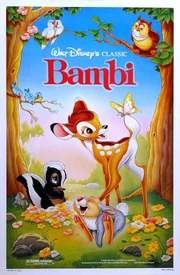
1988 Re-release Poster
- Main article: Bambi (video)
The film was re-released to theaters in 1947, 1957, 1966, 1975, 1982, and 1988. It was released on VHS in 1989 (Classics Version), 1997 (Masterpiece Collection Version), and digitally remastered and restored for March 1, 2005, 2-disc Platinum Edition DVD, and VHS. The 2-disc Platinum Edition DVD went on a moratorium on January 31, 2007. The Masterpiece Version was the first Disney Video to be THX certified.
Videos
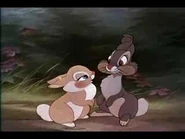
Bambi - Original Theatrical Trailer (1942)-2
1942 Original Theatrical Trailer
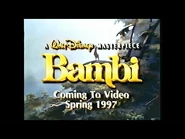
Bambi - 1997 VHS Trailer-2
1997 Home Video Trailer
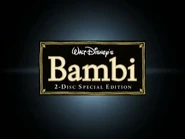
Bambi - Platinum Edition Trailer 2-2
2005 Platinum Edition Trailer
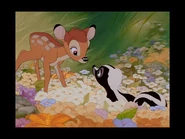
Bambi Blu-Ray - Official® Trailer -HD--2
2011 Diamond Edition Trailer
Anniversary Signature Edition Videos

Bambi Joins the Walt Disney Signature Collection
BambiAprilShowersStory 60 PREPOST h264 hd

Bambi BNS Grasshopper DeletedScene PrePreEndCard H264 720

Bambi BNS BambiEffect PrePreEndCard H264 720

Bambi BNS WaltAndDiane PrePreEndCard H264 720

Bambi BNS AnimatingWildlife PrePreEndCard H264 720

Bambi BNS AnimationSchool PrePreEndCard H264 720

Bambi Are You Twitterpated?

Bambi Africa Before Dark Bonus Piece

Bambi Fawn Facts

And Now A Message From Thumper
Smokey Bear Wildfire Prevention and Controversy
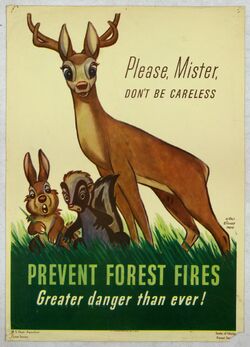
1943 US Forest Service poster featuring Bambi and friends
Soon after the film's release, Walt Disney allowed his characters to appear in fire prevention public service campaigns. However, Bambi was only loaned to the government for a year, so a new symbol was needed, leading to the creation of Smokey Bear. In 2006, the Ad Council, in partnership with the United States Forest Service, started a series of Public Service Announcement ads that featured footage from the film and its midquel for wildfire prevention. During the ads, as the Bambi footage is shown, the screen will momentarily fade into black with the text "Don't let our forests...become once upon a time", and usually (but not always) ending the ads with Bambi's line "Mother, what we gonna do today?" followed by Smokey Bear saying "Only you can prevent wildfires" as the Smokey logo is shown on the screen. The ads air on various television networks and the Ad Council has also put them on YouTube.
In March 1989, former U.S. Secretary of the Interior Manuel Lujan Jr. has criticized the film for propagating the idea that the best way to manage the forest resources within the U.S. was to fight forest fires. Secretary Lujan Jr. points out that controlled burning is now recognized as more beneficial, and that forest animals, such as Bambi, simply move out of the way of forest fires and, in general, are not killed by them. This is perhaps ironic, but an interesting indicator of changing scientific attitudes, as the U.S. Forest Service originally used Bambi with limited permission from Disney as their charismatic anti-fire mascot before they developed the now-famous Smokey Bear. Of course, since Bambi was made in 1942, before controlled burnings was theorized, most feel the Secretary of the Interior is overthinking the situation.
Midquel
- Main article: Bambi II
Bambi II was released as a midquel to the film. Set in the middle of it, it shows the Great Prince struggling to raise the orphaned Bambi, as he doubts about his father's love for him. It was released direct-to-video on February 7, 2006. While it was a direct-to-video release in countries like the United States, Japan, Canada, mainland China, Hong Kong, and Taiwan, it was a theatrical release in some countries like the United Kingdom, France, Austria, Mexico, Dominican Republic, Brazil, Australia, and some other European countries.
Copyrights
The copyrights for the film were inherited by Salten's daughter, Anna Wyler, who renewed them in 1954. After her death, her widower sold the rights to Twin Books, which subsequently filed a lawsuit against Disney, claiming Disney owed it money for the continued licensing for the use of the book. Disney countered by claiming that Salten had published the story in 1923 without a copyright notice, and was thus immediately entered into the public domain. Disney also argued that if the claimed 1923 publication date was accurate, then the copyright renewal filed in 1954 had been registered after the deadline and was thus invalid. The courts initially upheld Disney's view, however in 1996, the Ninth Circuit Court reversed the decision on appeal.
The film's copyright was renewed on March 26, 1969.[1]
Supervising animators
- Franklin Thomas, Milton Kahl, Eric Larson, and Oliver M. Johnston, Jr. (Bambi and Thumper)
- Ward Kimball (Faline)
Sequence directors
- James Algar, Bill Roberts, Norman Wright, Sam Armstrong, Paul Satterfield, Graham Heid (Bambi and Thumper)
- Ward Kimball (Faline)
Gallery
Trivia
- Reissued in spring 1966, the film was the last Disney animated one to have a reissue during Walt's lifetime.
- On December 17, 2018, an amusing sentence was passed against a man who was illegally hunting deer; he was forced to watch the film over and over again every month for his entire one-year sentence.[2]
- This is the first Disney animated film where no Humans are seen physically, however, Man were frequently mentioned in the film.
- The Platinum Edition release uses the shorter version of the 1990 Walt Disney Pictures logo at the start.
- It also uses the Restored English Language.
- The Diamond Edition release of the film uses the shorter version of the 2006 Walt Disney Pictures logo at the start and at the end.
- The Signature Collection release uses the original RKO Radio Pictures logo at the start and the 2006 Walt Disney Pictures logo with just Disney at the end.
References
- ↑ Catalog of Copyright Entries (1969 renewals)
- ↑ https://www.bbc.com/news/world-us-canada-46597364#:~:text=A%20poacher%20has%20been%20ordered,during%20his%20year%2Dlong%20sentence.
External links
| v - e - d | ||||||||||||
|---|---|---|---|---|---|---|---|---|---|---|---|---|
|
| v - e - d | ||||||||||||||
|---|---|---|---|---|---|---|---|---|---|---|---|---|---|---|
|
Source: https://disney.fandom.com/wiki/Bambi_(film)



0 Response to "To There and Back Again Achieve Bns"
Post a Comment